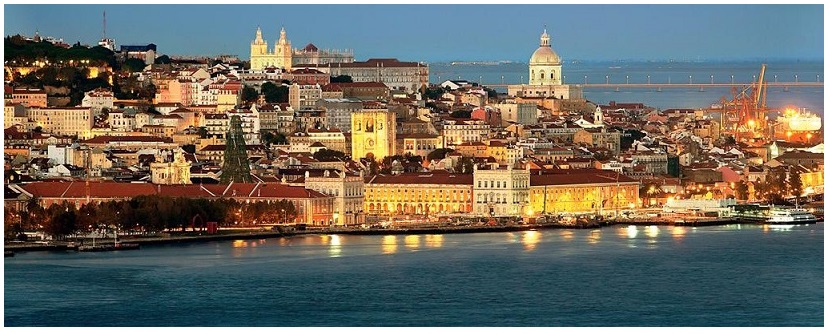|
History of Lisbon
The history of Lisbon, the capital city of Portugal, revolves around its strategic geographical position at the mouth of the Tagus, the longest river in the Iberian Peninsula. Its spacious and sheltered natural harbor made the city historically an important seaport for trade between the Mediterranean Sea and northern Europe. Lisbon has long enjoyed the commercial advantages of its proximity to southern and extreme western Europe, as well as sub-Saharan Africa and the Americas, and today its waterfront is lined with miles of docks, wharfs, and drydock facilities that accommodate the largest oil tankers.

During the Neolithic period, pre-Celtic peoples inhabited the region; remains of their stone monuments still exist today in the periphery of the city. Lisbon is one of the oldest cities in western Europe, with a history that stretches back to its original settlement by the indigenous Iberians, the Celts, and the eventual establishment of Phoenician and Greek trading posts (c. 800–600 BC), followed by successive occupations in the city of various peoples including the Carthaginians, Romans, Suebi, Visigoths, and Moors. Roman armies first entered the Iberian peninsula in 219 BC, and occupied the Lusitanian city of Olissipo (Lisbon) in 205 BC, after winning the Second Punic War against the Carthaginians. With the collapse of the Roman Empire, waves of Germanic tribes invaded the peninsula, and by 500 AD, the Visigothic Kingdom controlled most of Hispania.
In 711, Islamic Moors, who were mostly Berbers and Arabs from the Maghreb, invaded the Christian Iberian Peninsula, conquering Lisbon in 714. What is now Portugal first became part of the Emirate of Córdoba and then of its successor state, the Caliphate of Córdoba. Despite attempts to seize it by the Normans in 844 and by Alfonso VI in 1093, Lisbon remained a Muslim possession. In 1147, after a four-month siege, Christian crusaders under the command of Afonso I captured the city and Christian rule returned. In 1256, Afonso III moved his capital from Coimbra to Lisbon, taking advantage of the city’s excellent port and its strategic central position.
Lisbon flourished in the 15th and 16th centuries as the centre of a vast empire during the period of the Portuguese discoveries, This was a time of intensive maritime exploration, when the Kingdom of Portugal accumulated great wealth and power through its colonisation of Asia, South America, Africa and the Atlantic islands. Evidence of the city's wealth can still be seen today in the magnificent structures built then, including the Jerónimos Monastery and the nearby Tower of Belém, each classified a UNESCO World Heritage Site in 1983.
The 1755 Lisbon earthquake, in combination with subsequent fires and a tsunami, almost totally destroyed Lisbon and adjoining areas. Sebastião José de Carvalho e Melo, 1st Marquis of Pombal, took the lead in ordering the rebuilding of the city, and was responsible for the creation of the elegant financial and commercial district of the Baixa Pombalina (Pombaline Lower Town).
During the Peninsular War, (1807–1814) Napoleon’s forces began a four-year occupation of the city in December 1807, and Lisbon descended with the rest of the country into anarchy. After the war ended in 1814, a new constitution was proclaimed and Brazil was granted independence. The 20th century brought political upheaval to Lisbon and the nation as a whole. In 1908, at the height of the turbulent period of the Republican movement, King Carlos and his heir Luís Filipe were assassinated in the Terreiro do Paço. On 5 October 1910, the Republicans organised a coup d'état that overthrew the constitutional monarchy and established the Portuguese Republic. There were 45 changes of government from 1910 through 1926.
The right-wing Estado Novo regime, which ruled the country from 1926 to 1974, suppressed civil liberties and political freedom in the longest-lived dictatorship in Western Europe. It was finally deposed by the Carnation Revolution (Revolução dos Cravos), launched in Lisbon with a military coup on 25 April 1974. The movement was joined by a popular campaign of civil resistance, leading to the fall of the Estado Novo, the restoration of democracy, and the withdrawal of Portugal from its African colonies and East Timor. Following the revolution, there was a huge influx into Lisbon of refugees from the former African colonies in 1974 and 1975.
Portugal joined the European Community (EC) in 1986, and subsequently received massive funding to spur redevelopment. Lisbon's local infrastructure was improved with new investment and its container port became the largest on the Atlantic coast. The city was in the limelight as the 1994 European City of Culture, as well as host of Expo '98 and the 2004 European Football Championships. The year 2006 saw continuing urban renewal projects throughout the city, ranging from the restoration of the Praça de Touros (Lisbon’s bullring) and its re-opening as a multi-event venue, to improvements of the metro system and building rehabilitation in the Alfama.
|






